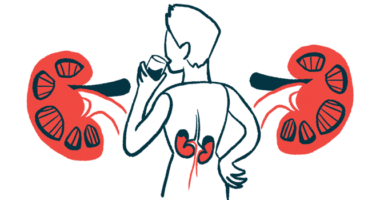C4d protein may be biomarker of ANCA-associated vasculitis activity
Protein's levels were found to drop with treatment to induce disease remission

People with ANCA-associated vasculitis (AAV) have significantly higher blood levels of C4d, a protein that reflects activation of the classic or lectin complement pathways of the immune system, a study in Sweden suggests.
Patients with self-reactive antibodies, called ANCAs, against the proteinase-3 (PR3) protein had significantly higher blood Cd4 levels and a higher C4d/C4 ratio than those with antibodies against the myeloperoxidase protein (MPO), data also shows. Also, C4d levels were found to drop with treatment to induce disease remission.
“This implies that the classical/lectin complement pathway may play a more significant role in AAV [development] than previously reported and that [blood] C4d levels and C4d/C4 ratio could potentially be used as biomarkers for monitoring disease activity and response to treatment.” The study, “Association of C4d with disease activity in anti-neutrophil cytoplasmic antibody-associated vasculitis: evidence for classical/lectin complement pathway activation,” was published in Arthritis Research & Therapy.
AAV is a group of autoimmune diseases where inflammation in small blood vessels damages several organs, including the kidneys. Most cases are caused by the production of self-reactive antibodies, or ANCAs, that target one of two proteins — PR3 or MPO — in neutrophils, a type of immune cell.
Excessive activation of the complement cascade, a part of the immune system composed of several blood proteins that are sequentially activated, is thought to contribute to AAV. This cascade can be activated through the classical, leptin, or alternative pathways. While there’s evidence of alternative pathway activation in AAV patients, little is known about the involvement of the classical and leptin pathways.
Measuring C4d blood levels
Here, researchers in Sweden measured blood levels of the complement factor 4 (C4) and its final activation fragment C4d, which are shared by the classical and leptin pathways, in 40 AAV patients and 20 population-based, age-matched healthy people.
The patients had a mean age of 55 and most were women (55%). Regarding AAV types, more than two-thirds (67.5%) had granulomatosis with polyangiitis (GPA), while 32.5% had microscopic polyangiitis (MPA). Most patients (82.5%) had kidney involvement, with a median estimated glomerular filtration rate (eGFR) — a standard measure of kidney function — of 71.4 mL/min/m3, corresponding to early-stage kidney disease.
Anti-PR3 ANCAs were present in 60% of the patients, while 40% had anti-MPA ANCAs. Those with anti-PR3 ANCAs or GPA, which is most often linked to anti-PR3 antibodies, were significantly younger and had better kidney function than those with anti-MPO ANCAs or MPA, which is most often associated with anti-MPO ANCAs.
Compared with healthy controls, AAV patients had significantly higher C4d blood levels (0.42 vs. 0.22 mg/L) and a higher C4d/C4 ratio (0.0016 vs. 0.001), reflecting a stronger activation of the classic/leptin complement pathways.
Blood levels of soluble C5b-9, the final product of each of the three complement pathways, were also significantly higher in people with AAV (0.23 vs. 0.16 mg/L).
Patients with anti-PR3-ANCAs had significantly higher levels of C4d than those with anti-MPO ANCAs. Similarly, blood C4d levels were significantly higher in GPA patients relative to MPA. Higher levels of ANCAs against PR3, but not those against MPO, were significantly associated with higher C4d levels and C4d/C4 ratio.
Kidney function and C4d levels
Among patients with kidney involvement, 81.3% of those with high C4d levels had anti-PR3 ANCAs, whereas 75% of those with low C4d levels had anti-MPO ANCAs.
“C4d levels were dependent on ANCA-autoantibody profiles suggesting differences in the role of complement activation in the underlying [disease] mechanisms,” the researchers wrote.
Further analysis indicated that patients with kidney involvement had significantly lower C4d levels than those without kidney damage (0.4 vs. 0.68 mg/L). Higher eGFR values, reflecting better kidney function, were associated with higher C4d levels and C4d/C4 ratio.
Similarly, higher C4d levels and C4d/C4 ratio in the blood were significantly associated with a greater proportion of normal glomeruli, the filtrating units of the kidneys, as assessed by kidney biopsies. C4d deposition in tissues, indicative of complement activation, was not detected in patients’ kidney samples.
“As we did not detect C4d in kidney biopsies in the current study, it is possible that patients with kidney involvement do not engage the classical/lectin complement pathway in kidneys,” the researchers wrote. “Instead, C4d may be [increased in the whole body] as a consequence of the inflammatory process in AAV or generated in other engaged organs.”
Follow-up blood samples, taken after about six months of induction treatment, were available for 24 patients, of whom 20 were in remission. There was a significant reduction in C4d levels and Cd4/C4 ratio after treatment, regardless of whether the analysis included all the patients or only those who achieved disease remission. Similar effects were seen for soluble C5b-9 levels, and regardless of the type of induction therapy used.
“The specific C4d assay revealed activity of the classical/lectin complement pathway in AAV, which reflected general disease activity, but was not specifically associated with kidney involvement,” the researchers wrote. “Larger studies on AAV, including specific organ involvement and outcome, could add to the utility of C4d in various AAV [profiles].”





